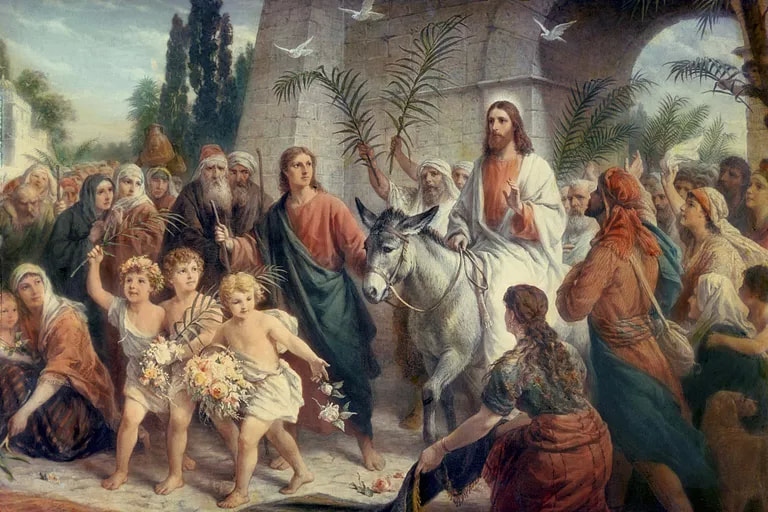|
Part 5 of the The Lord opens up with the entrance of Jesus into Jerusalem, on the back of a donkey. The crowds greet him by laying down palm branches, and all around are cheering and proclaiming the arrival of the Messiah. It truly would have been a sight to behold, and we can’t help but wonder what it actually would have been like to have been there. To have witnessed this triumphant arrival would certainly be a tremendous blessing. But was it really that grand of an affair, visually speaking? If we could look at it now as a video recording, would it look like how we would expect the Son of Man to openly reveal himself to the world? I don’t think so. I found myself thinking about this quite a lot lately. The current situation in the world with the COVID-19 pandemic has many of us sitting at home nearly all the time. We don’t go walking about the streets like we normally would, we don’t go about our normal routines of traveling to and from work or popping into the markets for an afternoon. But this situation is what made me think about the people who were there to welcome Jesus. This wasn’t a royal welcome. This wasn’t a parade filled with pomp filled with dignitaries and leaders all recognizing the kingship of the man on a donkey. But nor was it the opposite. It wasn’t just the poor out gathering to welcome the one who will overthrow the powers that have kept them so overburdened. Jesus surrounded himself with the poor and the downtrodden throughout his public ministry, so we might suspect this moment to act a crescendo for all he has done so far. We might expect it to serve as a contrast to the pomp of a worldly royal entrance, where instead of the rich and powerful it is the poor and weak who are there to celebrate their king. But neither of these things is what occurred. Instead, it was average people, going about their daily business. It was blacksmiths and tailors and shopkeepers and people just popping out to get a bite to eat. Not the poor or the rich, not the powerful or the weak, not the Jews or the Gentiles, there is no label or category we can put this crowd into, other than “they were people.” “Crowd in which we all could find our place—human reality, mediocrity bare of the pathos both of splendor and of misery.” But something about the fact of Jesus’s arrival changed everything about that boringly ordinary and mediocre crowd. It’s in his arrival to Jerusalem that Jesus ceases any attempt to conceal who he is. Here he openly proclaims himself the Messiah, the Son of God, and he does not back down from that claim even unto his death. His ride into the city is an act of revelation. That’s clear from the crowd’s response. Instead of going about their day and ignoring this man riding a donkey, surely not even a strange sight in the city, they all stop. The Holy Spirit moves through the crowd, enabling them to see the truth of who this man is and the significance of what is occurring. Suddenly all of these ordinary people are overcome with joy, for they can now truly see the God-man, and they all proclaim “Hosanna to the Son of David!” “Jesus acts—the same Spirit that inspires his action moves in those about him, revealing to them its meaning. Simultaneously, their eyes see the Lord as he rides through the street, and their spirit sees what is behind the event. The physical eye and the spiritual are one. And those who so truly ‘saw’ in that hour were not the particularly talented, neither geniuses nor in any way the elite or the mighty, but ‘the common people,’ those who happened to be in the streets at the time. For the power that opened their eyes and hearts was not human power, but the Spirit of God moving among men.” -Romano Guardini ("The Lord") Perhaps it’s how uninteresting and average this crowd was that finally tipped the scales for the powers of the day. The Pharisees had been opposed to Jesus for some time already, but the Sadducees had remained indifferent and aloof. It’s not until after his arrival that they begin to take him as a threat and begin to move against him. Perhaps it’s because they saw that he wasn’t just a Pharisee problem, nor even just a Roman problem. Something about him stirred the souls of everyone he encountered, regardless of class or race. In that act of revelation, Jesus became a Sadducee problem as well. In that moment, the Holy Spirit revealed to the world who Jesus was.
So would it have been that spectacular an affair to have been there? Absolutely! But only by the grace of the Holy Spirit moving within us. Without that grace, we would have just seen a wayward man on a donkey. But with it, we would have seen the Son. It is the same for us today. The Holy Spirit, the Advocate sent in Christ’s name by the Father (John 14:26) , is the one who teaches us to recognize such divine things, and how to respond to them. Only with the help of the Holy Spirit will we also be able to proclaim, in the here and now, “Hosanna in the highest!”
0 Comments
|
Series Info
Every day of Lent, I am writing a reflection piece on two chapters of "The Lord" by Romano Guardini. If you'd like to read or follow along, you can find the full calendar of where we're at below, or Click Here for the main landing page. Archives
April 2020
Categories
All
|

 RSS Feed
RSS Feed